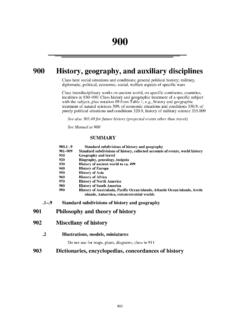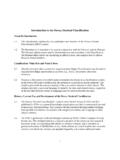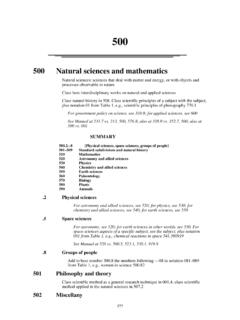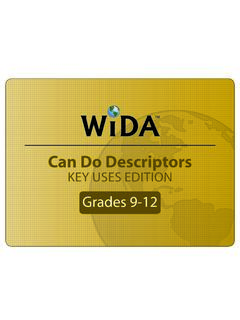Transcription of DDC 23 Summaries History and Current Use - OCLC
1 DDC 23 Summaries History and Current Use The Dewey Decimal Classification (DDC) system is a general knowledge organization tool that is continuously revised to keep pace with knowledge. The system was conceived by Melvil Dewey in 1873 and first published in 1876. The DDC is published by OCLC Online Computer Library Center, Inc. OCLC owns all copyright rights in the Dewey Decimal Classification, and licenses the system for a variety of uses. The DDC is the most widely used classification system in the world. Libraries in more than 140 countries use the DDC to organize and provide access to their collections, and DDC numbers are featured in the national bibliographies of more than 60 countries. Libraries of every type apply Dewey numbers on a daily basis and share these numbers through a variety of means (including WorldCat, the OCLC Online Union Catalog).
2 Dewey is also used for other purposes, , as a browsing mechanism for resources on the web. The DDC has been translated into over thirty languages. Translations of the latest edition of the DDC are completed, planned, or underway in Arabic, French, German, Italian, Norwegian, Spanish, Swedish, and Vietnamese. Development One of Dewey s great strengths is that the system is developed and maintained in a national bibliographic agency, the Library of Congress. The Dewey editorial office is located in the Decimal Classification Division of the Library of Congress, where classification specialists annually assign tens of thousands of DDC numbers to records for works cataloged by the Library. Having the editorial office within the CIP and Dewey Section enables the editors to detect trends in the literature that must be incorporated into the Classification.
3 The editors prepare proposed schedule revisions and expansions, and forward the proposals to the Decimal Classification Editorial Policy Committee (EPC) for review and recommended action. EPC is a ten-member international board whose main function is to advise the editors and OCLC on matters relating to changes, innovations, and the general development of the Classification. EPC represents the interests of DDC users; its members come from national, public, special, and academic libraries, and from library schools. Editions The DDC is published in full and abridged editions in print and web accessible versions. The abridged edition is a logical truncation of the notational and structural hierarchy of the corresponding full edition on which it is based, and is intended for general collections of 20,000 titles or less.
4 WebDewey, the electronic version of the classification is updated frequently and contain additional index entries and mapped vocabulary. Currently, the Abridged 15 edition is available to WebDewey subscribers in pdf form. Abridged numbers are indicated with segmentation marked. The electronic version and supplemental web postings are the chief sources of ongoing updates to the DDC. On the Dewey web site ( ), selected new numbers and changes to the DDC are posted regularly. Structure and Notation The DDC is built on sound principles that make it ideal as a general knowledge organization tool: meaningful notation in universally recognized Arabic numerals, well-defined categories, well-developed hierarchies, and a rich network of relationships among topics. In the DDC, basic classes are organized by disciplines or fields of study.
5 At the broadest level, the DDC is divided into ten main classes, which together cover the entire world of knowledge. Each main class is further divided into ten divisions, and each division into ten sections (not all the numbers for the divisions and sections have been used). The main structure of the DDC is presented in the DDC Summaries following this introduction. The headings associated with t he numbers in the Summaries have been edited for browsing purposes, and do not necessarily match the complete headings found in the schedules. The first summary contains the ten main classes. The first digit in each three-digit number represents the main class. For example, 600 represents technology. The second summary contains the hundred divisions. The second digit in each three-digit number indicates the division.
6 For example, 600 is used for general works on technology, 610 for medicine and health, 620 for engineering, 630 for agriculture. The third summary contains the thousand sections. The third digit in each three-digit number indicates the section. Thus, 610 is used for general works on medicine and health, 611 for human anatomy, 612 for human physiology, 613 for personal health and numerals are used to represent each class in the DDC. A decimal point follows the third digit in a class number, after which division by ten continues to the specific degree of classification subject may appear in more than one discipline. For example, clothing has aspects that fall under several disciplines . The psychological influence of clothing belongs in as part of the discipline of psychology; customs associated with clothing belong in 391 as part of the discipline of customs; and clothing in the sense of fashion design belongs in as part of the discipline of the arts.
7 Hierarchy Hierarchy in the DDC is expressed through structure and notation. Structural hierarchy means that all topics (aside from the ten main classes) are part of all the broader topics above them. Any note regarding the nature of a class holds true for all the subordinate classes, including logically subordinate topics classed at coordinate numbers. Notational hierarchy is expressed by length of notation. Numbers at any given level are usually subordinate to a class whose notation is one digit shorter; coordinate with a class whose notation has the same number of significant digits; and superordinate to a class with numbers one or more digits longer. The underlined digits in the following example demonstrate this notational hierarchy: 600 Technology Agriculture and related technologies 630 636 Animal husbandry Dogs Cats Dogs and Cats are more specific than ( , are subordinate to) Animal husbandry ; they are equally specific as ( , are coordinate with) each other; and Animal husbandry is less specific than ( , is superordinate to) Dogs and Cats.
8 Sometimes, other devices must be used to express the hierarchy when it is not possible or desirable to do so through the notation. Special headings, notes, and entries indicate relationships among topics that violate notational hierarchy. Arrangement of the DDCThe print version of the latest full edition of the DDC, edition 23, is composed of the following major parts in four volumes: Volume 1 (A) Introduction: A description of the DDC and how to use it (B)Glossary: Short definitions of terms used in the DDC(C)Index to the Introduction and Glossary(D)Manual: A guide to the use of the DDC that is made up primarily of extended discussions of problem areas in the application of the DDC. Information in the Manual is arranged by the numbers in the tables and schedules.
9 (E) Tables: Six numbered tables of notation that can be added to class numbers to provide greater specificity Volume 2(F) Schedules: The organization of knowledge from 000 599 Volume 3(G) Schedules: The organization of knowledge from 600 999 Volume 4(H) Relative Index: An alphabetical list of subjects with the disciplines in which they are treated subarranged alphabetically under each entry EntriesEntries in the schedules and tables are composed of a DDC number in the number column (the column at the left margin), a heading describing the class that the numberrepresents, and often one or more notes. All entries (numbers, headings, and notes) should be read in the context of the the print version of the DDC, the first three digits of schedule numbers (main classes, divisions, sections) appear only once in the number column, when first used.
10 They are repeated at the top of each page where their subdivisions continue. Subordinate numbers appear in the number column, beginning with a decimal point, with the initial three digits numbers in the schedules and tables are enclosed in parentheses or square brackets. Numbers and notes in parentheses provide options to standard practice. Numbers in square brackets represent topics that have been relocated or discontinued, or are unassigned. Square brackets are also used for standard subdivision concepts that are represented in another location. Numbers in square brackets are never Building Only a fraction of potential DDC numbers are included in the schedules. It is often necessary to build or synthesize a number that is not specifically listed in the schedules.
















